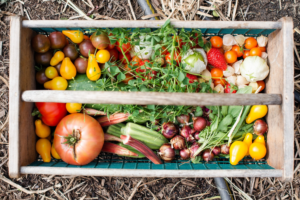
Blossoming Good Vibes: Transforming the Community Church
Sometimes all a satellite location needs is subtly updated curb appeal to help get the attention of those walking, riding or driving by in the local community. And that’s where plants—natural, colorful, welcoming and inexpensive—can create a visual pop that attracts people’s gazes and makes them want to visit and linger.
In Georgia, where there’s always something green going on, Jenneke Somerville, floral aficionado and owner of Grandiflora, a fine gardening company in the Peach State’s city of Athens, shares some ideas any church’s staff can use.
Design with plants, fruits and vegetables
“Try pots of tropical plants outside, mixed with annuals, mixed with vegetables (okra is very sculptural),” Somerville suggests.
“Try cactus, agaves, succulents, herbs and bulbs indoors or on porches to extend the gardening season well into winter,” she adds. Whatever plants are chosen, they can be contained in pots, urns, bowls, terra cotta planters, and wood bowls, whether inside or out.
Engaging kids from the children’s ministry is a fun way to get some creative planting going on and to teach about God’s creation in the process. Engage with kids outside by planting vegetables, for example, and plant fragrant flowers and fruits like blueberries and strawberries in the process.
It doesn’t matter whether or not a multisite has real estate to work with. As Somerville reminds, “These things can be planted in the middle of decorative plantings. You don’t need a designated vegetable garden to enjoy a tomato out of your garden.”
Whatever your staff decides, Somerville suggests experimentation with plants. “I also see plantings in pots with unexpected plants,” she adds, like olive trees and palms.
Another Somerville design move that’s right for multisites is what she calls “plants on wheels,” the idea being that if you don’t like a planter in one location or you find you need it in another, just move it.
For indoor décor at the multisite, she reminds staff gardeners to use what they’ve planted to perform double-duty—using cut flowers and foliage to decorate, as needed.
“I love pushing the limits with plants,” she shares. “The joy of gardening is that nothing is ever static.”

Demonstrate environmental stewardship
Some ways a multisite can show Creation Care in action are to use plants native to a particular site’s region.
Somerville suggests this easy environmentally sensitive move for plantings in outdoor spaces: “Use some plants that are native and encourage insect habitat and birds in the garden to keep everything balanced.”
So many people and businesses use lawn companies that spray and destroy great amounts of natural habitat. “It is a big challenge to get people to accept weeds and insects into their spaces,” she notes.
Using local businesses, reducing lawn chemicals, and choosing reclaimed and recycled planters and materials, inside and out, are all solid environmental choices, the garden designer adds.
Sit back, relax, pray and meditate
If a renovation budget allows, Somerville suggests installing moon lighting at multisites fortunate enough to have any amount of outdoor garden space.
“It can completely transform a garden space for use in the evening,” she says. “It is like having a full moon casting through the trees”—one that sets white and light-colored flowers aglow without adding to area light pollution.
Somerville closes, “Designing an outdoor space for relaxation, watching the sun go down, and listening to the birds is the key to helping turn down the stresses.”
And from there, churchgoers and community visitors are ready to connect, reflect and pray.






